Biography of Nicholas Johnson -1624
Nicholas Johnson -1624 is in Sculptors.
Nicholas Johnson was born to Gerard Johnson The Elder.
After 21 Feb 1581. Church of St Peter and St Paul, Exton, Rutlandshire [Map]. Elizabethan Period monument to Robert Keilway (deceased). This memorial is attributed by Pevsner to Nicholas Johnson and by others to Nicholas Stone. Made of various marbles, a large standing wall monument of 1580, richly decorated and with a recumbant and kneeling figures of the whole family, in an aedicule, capped by obelisk, arms, etc.
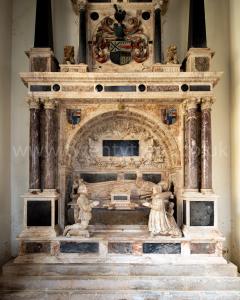
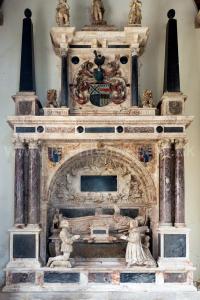
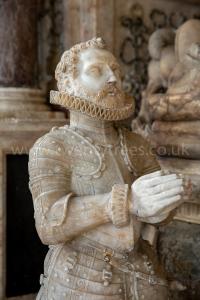
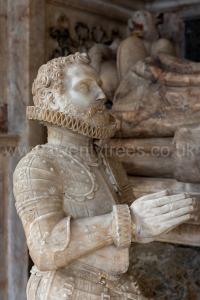
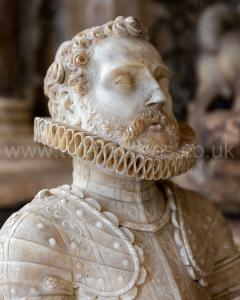 His son-in-law John Harington 1st Baron Harington (age 41).
His son-in-law John Harington 1st Baron Harington (age 41).
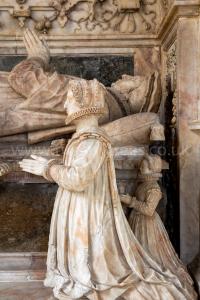
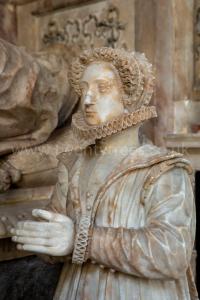
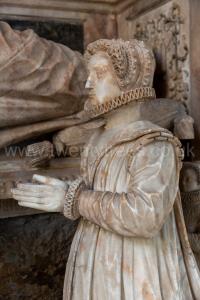
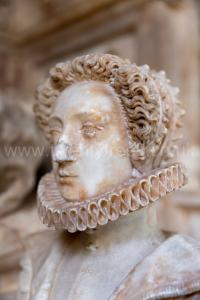 His daughter Anne Keilway Baroness Harington (age 27).
His daughter Anne Keilway Baroness Harington (age 27).
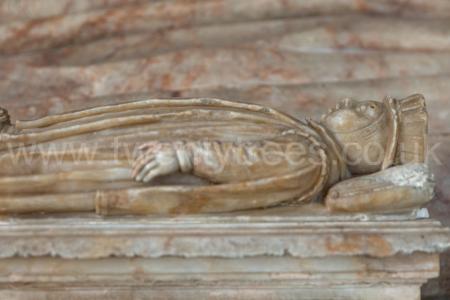
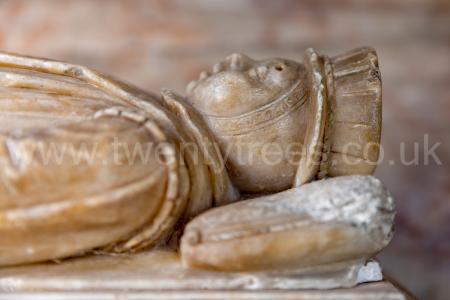

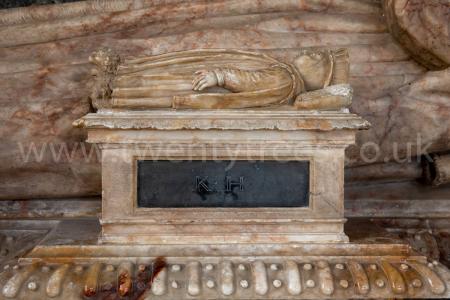
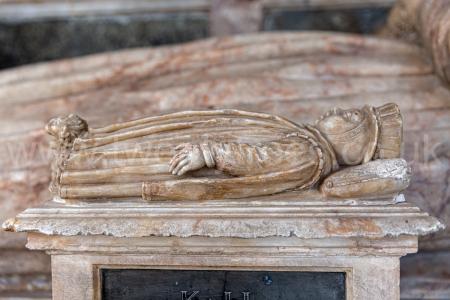 His grandson Kelwey who died aged 21 weeks.
His grandson Kelwey who died aged 21 weeks.
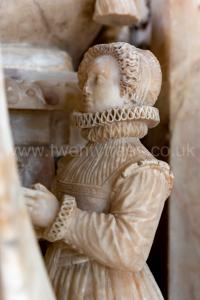 His grand-daughter Lucy Harrington Countess Bedford (age 1).
His grand-daughter Lucy Harrington Countess Bedford (age 1).
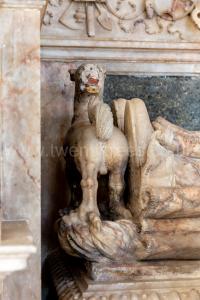 His feet resting on a horse with its head turned back.
His feet resting on a horse with its head turned back.
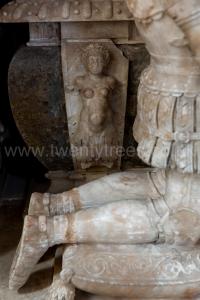
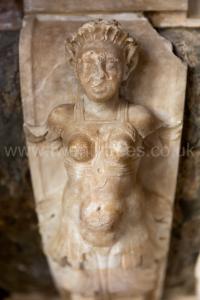 A Harpy. The begin to appear at the end of the 16th Century - see All Saints Church, Turvey [Map].
A Harpy. The begin to appear at the end of the 16th Century - see All Saints Church, Turvey [Map].
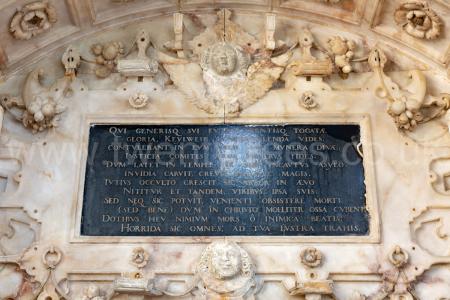
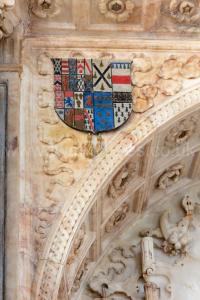
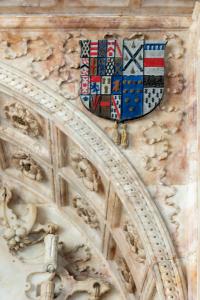 The same armorial on both sides include
The same armorial on both sides include  Harrington Arms,
Harrington Arms,  Keilway Arms
Keilway Arms
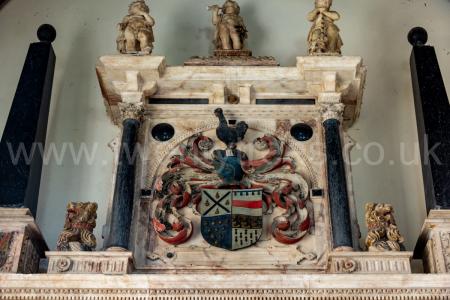 His arms quartered 1:
His arms quartered 1:  Keilway Arms.
Keilway Arms.
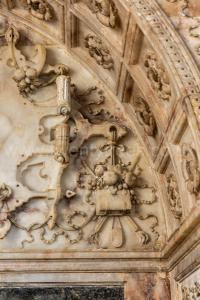
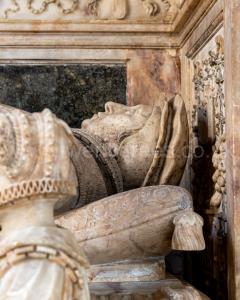
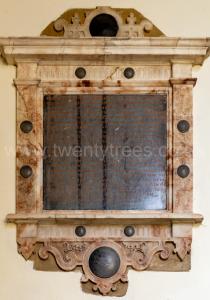 A separate wall mounted monument to Robert Keilway (age 84) with the inscription "Here lies Robert Keylway a distinguished esquire among civilians (whilst he lived), renowned for talent, learning and virtue, who loved retirement, lived as a Christian and died in the Lord on the 21st of February 1581 in the year of our Salvation, 1580, and the 84th year of his age. He left Anne (age 27) his sole heiress and only dearly loved daughter married to John Harrington of Exton, Knt (age 41), whom he had always affectionately loved as a son and friend, by which Anne (age 27) the said John (age 41) had during the life of the aforesaid Robert (deceased) two children, a son, Kelwey, who died Dec. 2nd, 1570, 21 weeks old, and lies buried here with his grandfather, and also a daughter Lucy (age 1) still surviving, and may God grant her a long life. To pay, therefore, a just tribute to so dear and affectionate a parent and to leave to posterity an evidence of their deep gratitude, the said John (age 41) and Anne (age 27) have raised this. Monument and dedicated to their father, Keylwey, and their son Keylwey (to their lasting memory if it so please God) and design it, if God will, as a sepulchre for themselves also".
A separate wall mounted monument to Robert Keilway (age 84) with the inscription "Here lies Robert Keylway a distinguished esquire among civilians (whilst he lived), renowned for talent, learning and virtue, who loved retirement, lived as a Christian and died in the Lord on the 21st of February 1581 in the year of our Salvation, 1580, and the 84th year of his age. He left Anne (age 27) his sole heiress and only dearly loved daughter married to John Harrington of Exton, Knt (age 41), whom he had always affectionately loved as a son and friend, by which Anne (age 27) the said John (age 41) had during the life of the aforesaid Robert (deceased) two children, a son, Kelwey, who died Dec. 2nd, 1570, 21 weeks old, and lies buried here with his grandfather, and also a daughter Lucy (age 1) still surviving, and may God grant her a long life. To pay, therefore, a just tribute to so dear and affectionate a parent and to leave to posterity an evidence of their deep gratitude, the said John (age 41) and Anne (age 27) have raised this. Monument and dedicated to their father, Keylwey, and their son Keylwey (to their lasting memory if it so please God) and design it, if God will, as a sepulchre for themselves also".

On 24 Jan 1592 James Harrington (age 81) died. He was buried in the Church of St Peter and St Paul, Exton, Rutlandshire [Map]. Monument to James Harrington (age 81) and Lucy Sidney. A large standing Elizabethan Period monument with 2 kneeling figures at a prie-dieu in a double aedicule. Wrought in various marbles and enriched with low-relief carving, strapwork etc. surmounted by obelisk, and arms. Stylistically similar to the monument to Robert Keilway. Possibly sculpted by Nicholas Johnson or Nicholas Stone (age 5).

Lucy Sidney: James Harrington and she were married. Around 1520 she was born to William Sidney and Anne Pakenham at Penshurst, Kent. Around 1591 Lucy Sidney died at Exton, Rutlandshire.
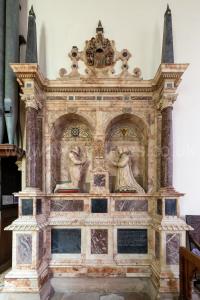
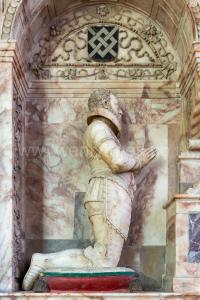
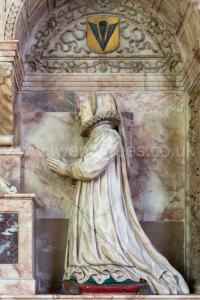
On 25 Mar 1605 Elizabeth Russell Countess Bath was buried at St Peter's Church, Tawstock [Map]. After 12 Jul 1623 William Bourchier 3rd Earl Bath (age 65) was buried with his wife.

The monument subject to restoration and repainting around 1980.
Monument, possibly by Nicholas Johnson, with Latin inscriptions: Æ.S. Lege viator quæ Magnatum saxa rarissime, loquuntur vir probus et mobilis utero hic situs est Guiliemus Bourgchier Comes Bathone nsis æternitatem apud motales meritus Suauissimo connubio connnxit nobii tatem et virtutem utranq dignitatum in omnibus constanter retinvit et ornavit vixit in hac ipsa Devonia cvi datus est praefectus et puincian triginta pius minus annis integerppime administravit Deum tam privatis quam publicis officus religiosissime colvit magnificum exemplum beneficentiæ, et hosptalitatis pavprervmq et oppressorum acerrimus patronus diniq cum inoffensae foelicitatis cursum ad sinium vsq propuxisset decessit e vivis incens et aeternum Devoniae suæ desiderium 12 July anno salvitus 1623 ætatis vero suæ 65. Uxorem duxit lectissimam toeminan sociam ... sepulchri dnam Elizabetham Francisci Comitis Bedfordensis Filiam ex qua genuit Johem Robertum et Edwardum Filios et Franciscam Filiam E quibus Edwardum modo Comitem Bathoniensem solum reliquit supersitem ipsoum clarissimæ familiæ suis quoq virtutibus et foelicissimo conivgio futurum ornamentum. Hoc fac et vives.
"Reader, read what the rare stones of the great ones seldom speak, here lies buried William Bourchier, Earl of Bath, deserving of eternity among mortals. He united nobility and virtue by a most delightful marriage, consistently maintaining and adorning both dignities in all things. He lived in this very Devonshire, over which he presided as prefect and justice of the peace for thirty years with the utmost integrity. He devoutly worshipped God in both private and public duties, magnificently exemplifying benevolence, hospitality, and being the most ardent protector of the oppressed. When he had set forth the course of his harmless happiness to the bosom of eternity, he departed from the living, leaving behind an incense and eternal longing for his Devonshire. On July 12th, in the year of salvation 1623, at the age of 65. He married the most distinguished lady, Elizabeth, daughter of Francis, Earl of Bedford, by whom he begot John, Robert, and Edward, sons, and Frances, a daughter. Of these, he left surviving only Edward, now Earl of Bath, a future ornament to his most illustrious family by his own virtues and most happy marriage. Do this, and you will live."
BATHONÆ COMTIÆ DEVON PRAEFECTO MEMORIÆ ERGO Ana: Crono: Epi: Mors mihi Ivcrvm ... In grama tum ... Bon Temps viendra Morior ... Orior ... Ad sepul crum ... Finis ... Coronat Ana: Gulielmus Bourchier Luge (si ob Iucrum Heri) Quid sibi vult Tumulus. Quaeve hoec Insignia Iuctus Eft COMES in Svperos ecce LOCUMQ TENES Quare fles, Devonia vel, Bathonia, qvare eXIIt: en bon teMps nVnCo VIenDra patet (Crono) IVLIVS, hoc, mensis fuit AUGUSTISSIMUS, anno Atq SECUNDA (decem junge) SECUNDA dies Non amor, invidia est, DOLOR, euge, lege, (ALME VIATOR) Et difce exemplo VIVERE, disce mori. Sic cecinit, non elevit.
To the memory of William Bourchier, Earl of Bath, Prefect of Devon: Ana: Chrono: Epitaph: Death is my Law ... Then in the grave ... Good Times will come. I die ... I rise ... To the tomb ... The End ... Ana crowns: William Bourchier Mourn (if for the joy of yesterday) What does the Tumulus mean? What does this Emblem of Grief signify? BEHOLD, the Earl holds a place among the heavens. Why do you weep, Devon or Bath, why do you mourn: behold, good times are coming, soon they will come (Chronos) JULY, this, was the most AUGUST month, in the year and the second day (join ten) The second day. Not love, but envy is SORROW, hail, read (kind traveler) And learn to live by example, learn to die. Thus he sang, not did he elevate.
The Plantagenet Arms indicate his being a 6 x Great Grand Son of King Edward III of England through his paternal grandfather John Bourchier 2nd Earl Bath and his paternal grandmother Eleanor Manners Countess Bath.

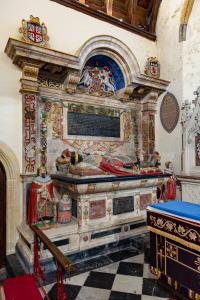
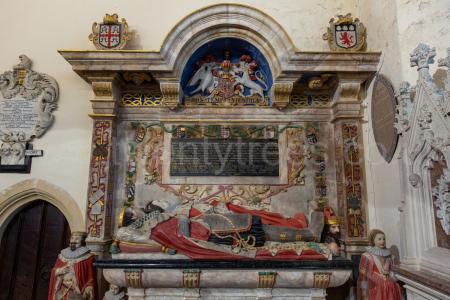
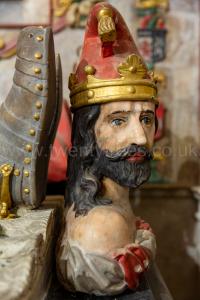
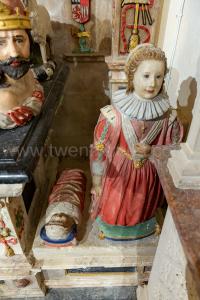
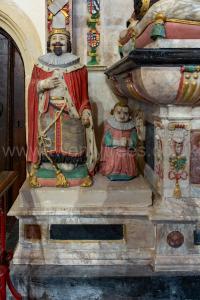
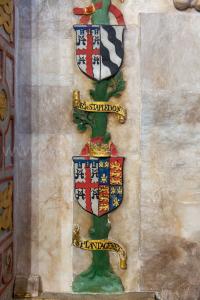
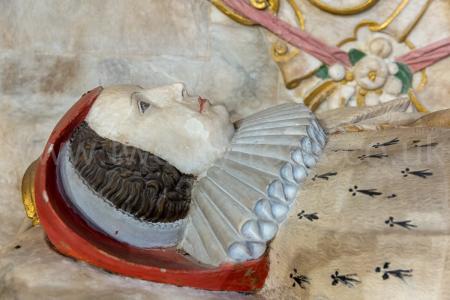
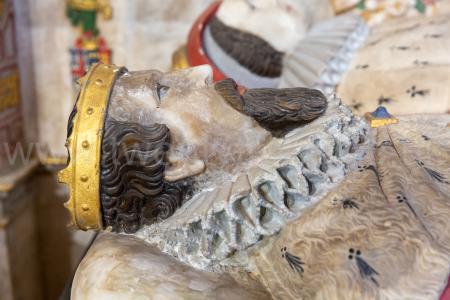
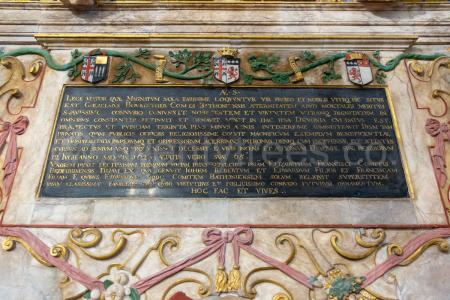
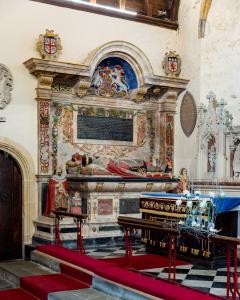
Before 30 Jul 1611 [his father] Gerard Johnson The Elder (age 61) died. He was buried at Southwark Cathedral [Map] on 30 Jul 1611.
After 26 Jun 1612. Elizabethan Period monument to Roger Manners 5th Earl of Rutland (deceased) and Elizabeth Sidney Countess Rutland at St Mary the Virgin Church, Bottesford, Leicestershire [Map] sculpted by Nicholas Johnson. Cost £150 including carriage by sea from London to Boston [Map].

Elizabeth Sidney Countess Rutland: In 1585 she was born to Philip Sidney and Frances Walsingham Countess Essex. On 05 Mar 1599 Roger Manners 5th Earl of Rutland and she were married. She by marriage Countess of Rutland. Childless, unhappy and possibly not consummated. She the daughter of Philip Sidney and Frances Walsingham Countess Essex. He the son of John Manners 4th Earl of Rutland and Elizabeth Charlton Countess Rutland. In 1612 Elizabeth Sidney Countess Rutland died. She was buried at St Mary the Virgin Church, Bottesford, Leicestershire.
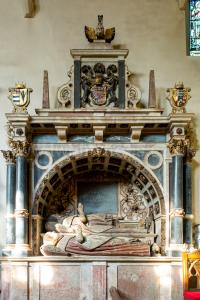
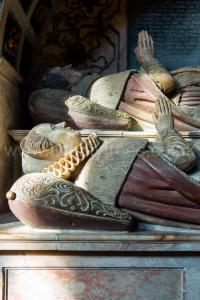
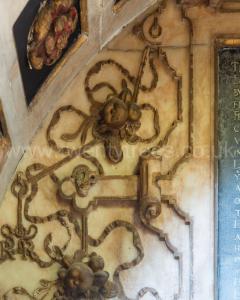
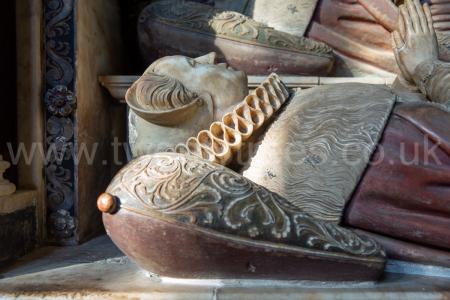
In 1624 Nicholas Johnson died. He was buried at Southwark Cathedral [Map].